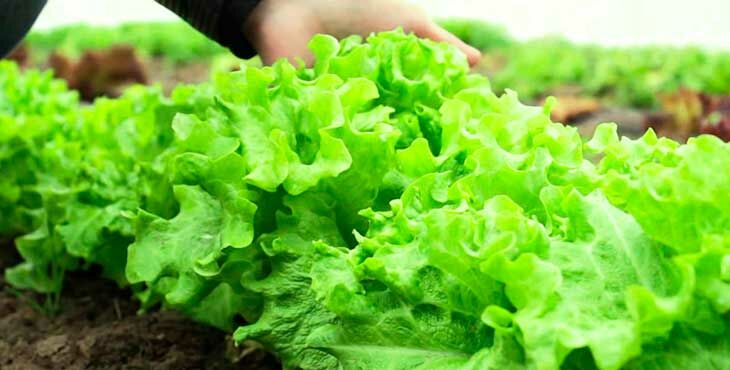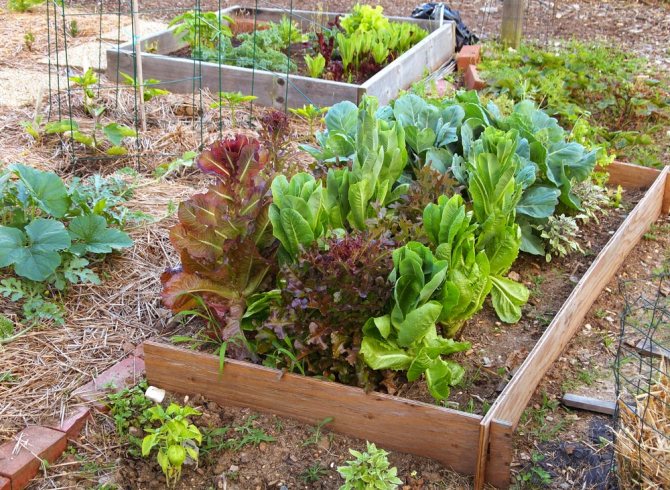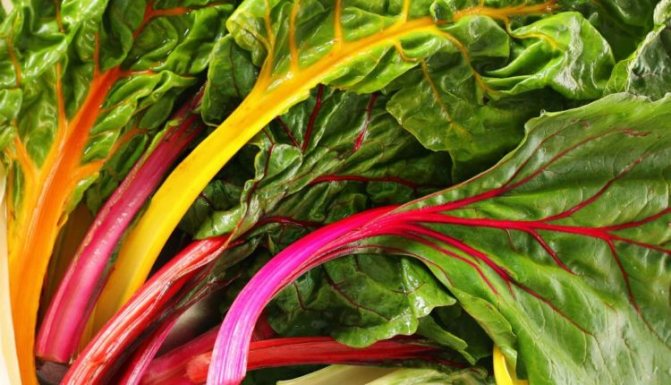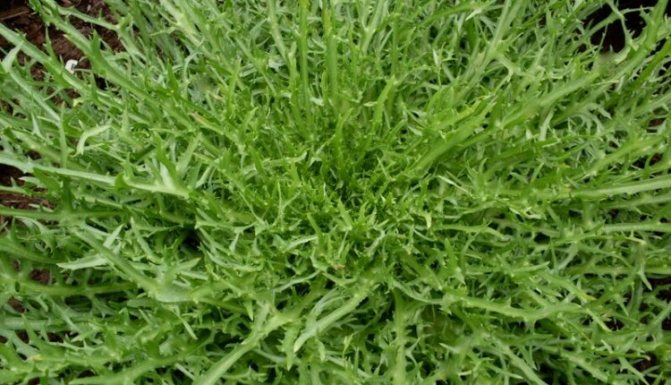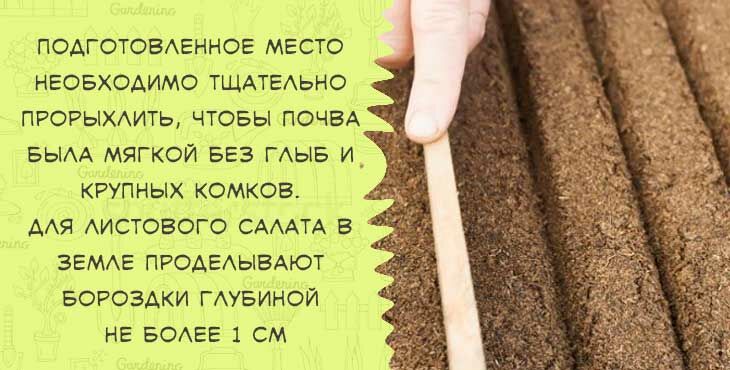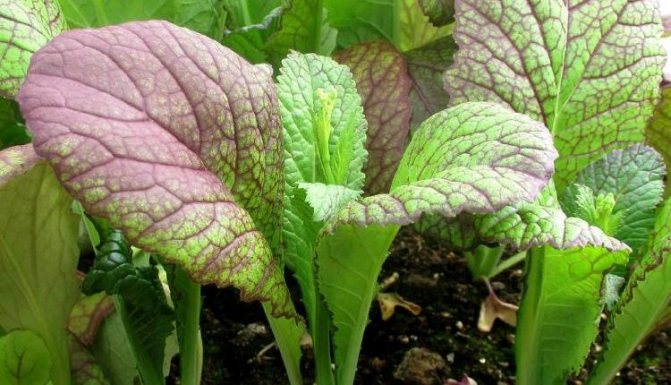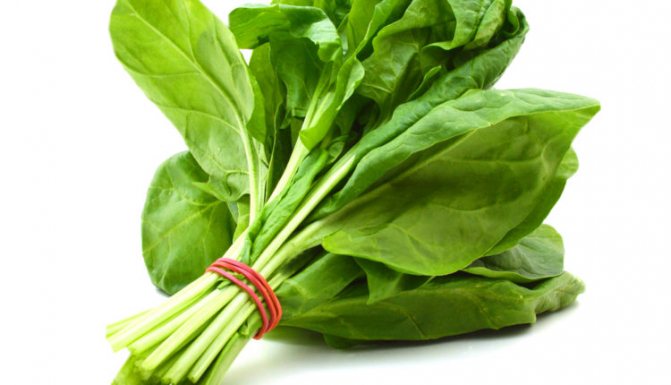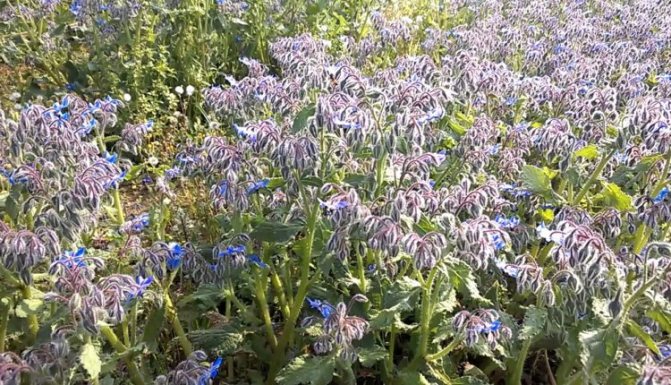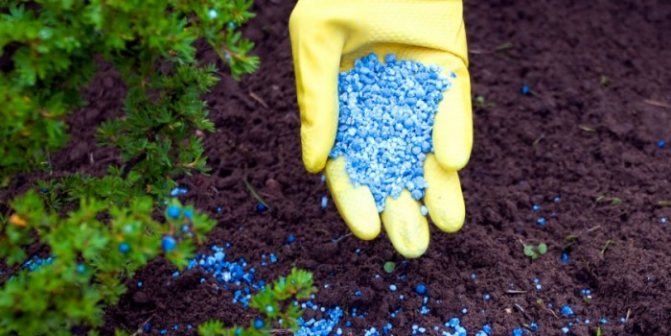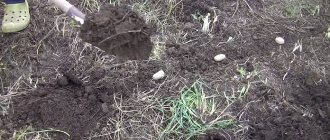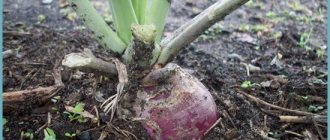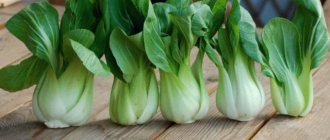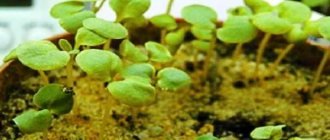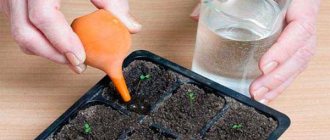Growing lettuce in the open field does not cause any trouble to the summer resident, and there are many benefits from it. Lettuce contains almost all groups of vitamins and many minerals: potassium, calcium, manganese, iron, iodine, copper, molybdenum, boron, as well as organic acids. The use of lettuce leaves promotes proper digestion, speeds up and normalizes metabolism. Only there is a prerequisite - the leaves should not undergo heat treatment, i.e. the faster they are from the garden, the more useful.
Temperature and humidity conditions.
Lettuce is a cold-resistant, light-loving and moisture-loving culture, like radish. The needs of these cultures are also practically the same. Sowing radishes and lettuce in the same garden is a good solution. They will protect each other from pests.
Lettuce seeds begin to germinate at +4 + 5 ° C, so they must be sown immediately after the snow melts, in slightly warmed soil. Seedlings can withstand frosts painlessly down to -2 -4 ° C, and mature plants with 4 - 5 true leaves can withstand up to -6 - 8 ° C.
The optimum temperature for plant development is +15 + 20 ° C, it is in this temperature range, provided there is sufficient soil and air moisture, that active growth of green mass begins. With an increase in temperature of more than +20 + 25 ° C, the plant gives less greenery, withers and shoots an arrow with seeds. Also, at elevated temperatures, seeds germinate poorly, so you should not wait for real summer for sowing lettuce.
Lettuce is picky about the sun and light, does not like to grow in deep shade. It is preferable to plant it in open, sunny areas in early spring. If you are late with your spring planting, then plant the lettuce in shaded areas. The scorching hot sun completely stops the growth of the lettuce, so try to shade the seedlings with other crops.
Lettuce cannot develop without an abundance of moisture in the soil and air. Therefore, it is advisable to water it every day, and preferably in the evening (after sunset). Moreover, it is better to water by sprinkling, wetting the leaves with water too, but not in the heat.
What kind of soil?
It is best to grow lettuce on loose soils with a large amount of organic matter and trace elements, while the acid reaction of the soil should be neutral or slightly alkaline from 6.0 to 7.2 pH.
Acidic, saline, heavy clay soils are not suitable for growing lettuce. Otherwise, the salad is unpretentious, i.e. grows well on sand, and on loam, and on black soil, and on calcareous soils.
It is necessary to prepare the beds for lettuce in advance, in the fall. It is advisable to use those beds on which fertilizers were applied. In autumn, they must be loosened and, if desired, add rotted manure or compost at the rate of a bucket per 1 m2. We leave everything as it is, until spring.
Due to the fact that the root system of the lettuce is not buried, the soil must always be kept loose and moist.
The history of growing lettuce
Lettuce is an annual crop that has been around for a long time. The ancestor of the modern garden salad is the compass salad, which lives in the wild in Europe, Asia and America. Salad became a cultivated plant in the Mediterranean long before our era.Historians testify that at first it was domesticated by the Egyptians, then the salad moved to ancient Greece, where it was used for both food and medicinal purposes. The Romans considered it a dessert, and later turned it into an appetite-inducing snack.
In Russia, lettuce began to be grown in large quantities in the middle of the 19th century. Now it can be found in almost any amateur garden; lettuce is also cultivated on an industrial scale, and all year round. Perhaps, this culture is most respected in the countries of Western Europe, but lettuce is cultivated in almost all corners of the globe. They do this both in the open field and in various greenhouses.
Lettuce varieties
The classification of lettuce plants is very difficult. In addition to the many varieties of salad we are used to, there are many other types of salad plants. So, these include:
- watercress;
- field salad;
- arugula;
- chicory salad;
- lettuce kale;
- lettuce, etc.
However, agricultural techniques of various types are very similar. There are a dozen or so varieties of watercress, sometimes called bedwort. Its cultivation is completely elementary: after sowing the seeds, you can do nothing at all, and after 2–3 weeks you can pick off small leaves of vitamin greens, which are used directly for food and to decorate various dishes.
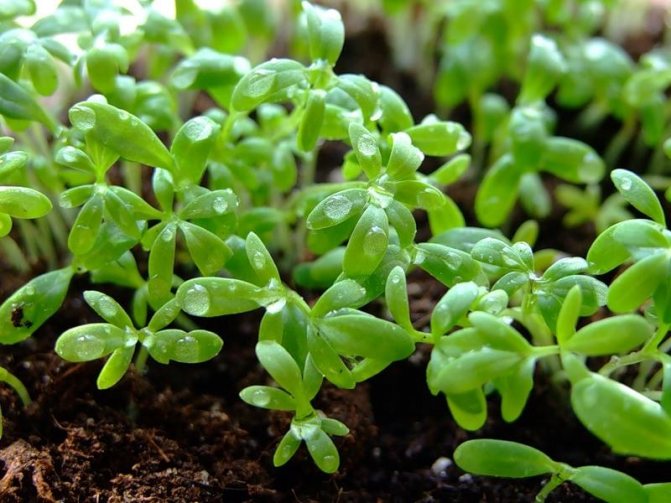
Watercress is one of the earliest crops
Not everyone likes watercress, but most gardeners sow it in early spring, appreciating the simplicity and benefits of this plant.
Just a few years ago, the fashion for arugula came to our country; Few people knew this salad variety before. Arugula is considered the closest relative of dandelion, and its taste is very similar to the taste of the leaves of this weed. Openwork gray-green leaves are on very thin stems, they are rich in ascorbic acid and iodine, go well with meat, seafood, add spice to many dishes. Arugula is believed to have aphrodisiac properties.
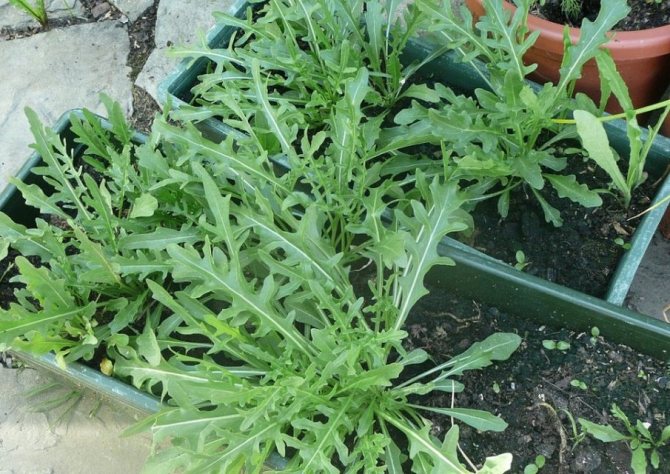

Arugula is a useful plant, but not for everyone
However, the most common in Russia are various types of lettuce (leaf and head lettuce). Perhaps the most famous of the head varieties is the Iceberg lettuce. It is practically a copy of white cabbage, even crunches in the same way. Withstands low temperatures, well stored in a refrigerator. Combines with a wide variety of products. The large leaves of the Iceberg are also used as mini salad bowls. The value of the variety is that it contains practically no calories, but is rich in vitamins and other useful substances. Used in dietetic food.
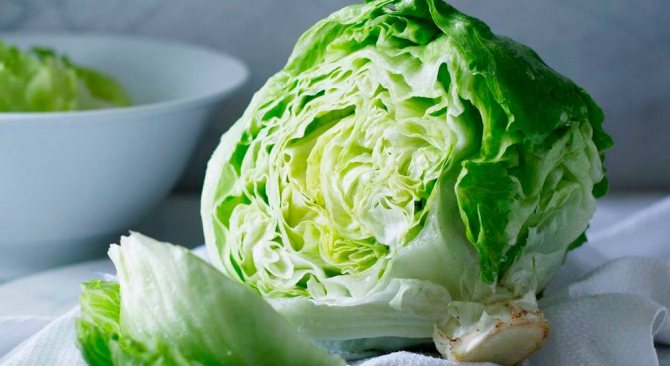

Iceberg lettuce is not easy to distinguish from cabbage
Small heads of cabbage, no longer very similar to cabbage ones, form the well-known Berlin Yellow salad, grown since 1963. It is mid-ripening, has oily leaves collected in a medium-density rosette with a diameter of up to 30 cm. Plant weight - up to 200 g, yield up to 4.5 kg / m2. The medium-late variety Kucheryavets Odesskiy belongs to the head salads. The leaves are crispy, bubbly, light green. Head of cabbage weighing up to 200 g, yield up to 2.7 kg / m2.
Somewhat more often, leafy forms of lettuce are grown in personal gardens. Some of the most famous varieties are Lollo-Rosso and Lollo-Biondo. Bright leaves with curly edges are colored in various shades of green and reddish brown. The taste is bitter, with hints of nut, suitable for various dishes. The varieties are used in dietetic food.
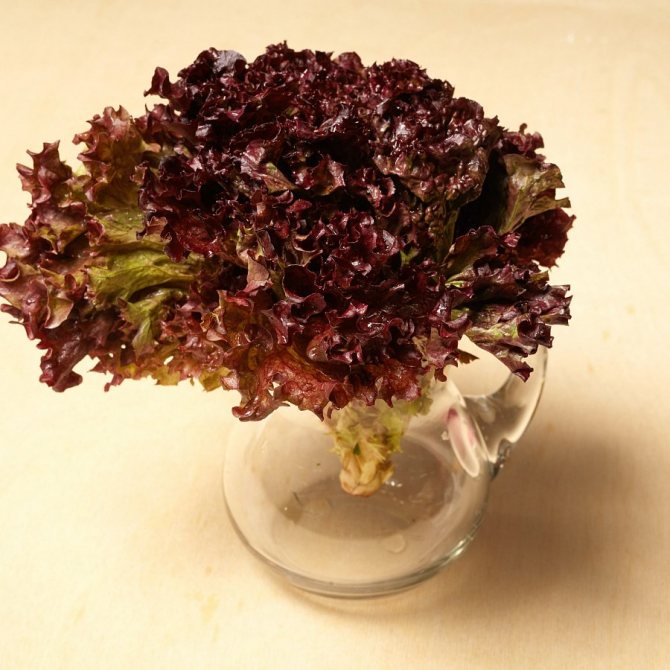

Even the appearance of Lollo Rosso salad suggests that it contains iodine.
The leaves of oak (oakleaf) lettuce are red or green in color, the shape corresponds to the name. The nutty flavor allows you to combine the salad with various sauces, mushrooms and fish. One of the champions in the content of various nutrients.The disadvantage of oaky lettuce is that it is practically not stored fresh.
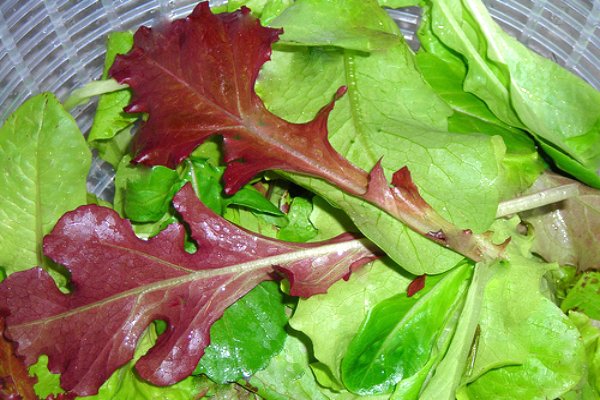

Oaky salad is very useful, if only it did not spoil so quickly
Vitamin salad is mid-season, reaches a height of 21 cm, a slightly wider rosette spreads out to the sides. The leaves are light green, large, medium blistering, slightly wavy at the edges. The taste of the leaves is equally delicate at all stages of development of this salad. The mass of one plant reaches 250 g, from 1 m2 up to 3.2 kg are harvested.
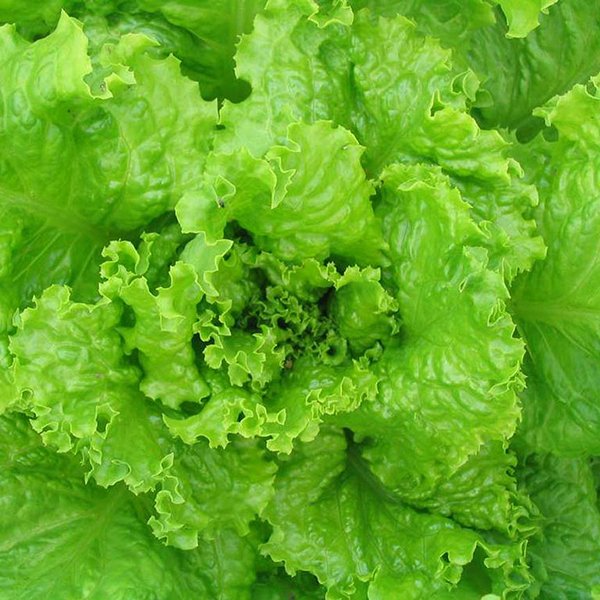

Vitamin delicious at any time of the year
Since the beginning of the century, the Emerald Lace lettuce has been grown, which forms oily leaves of medium size, bright green in color. The variety is mid-season, excellent taste, high-yielding: plant weight over 350 g, from 1 m2 harvested up to 5 kg. The variety can grow even in partial shade, which is usually uncommon for salads.
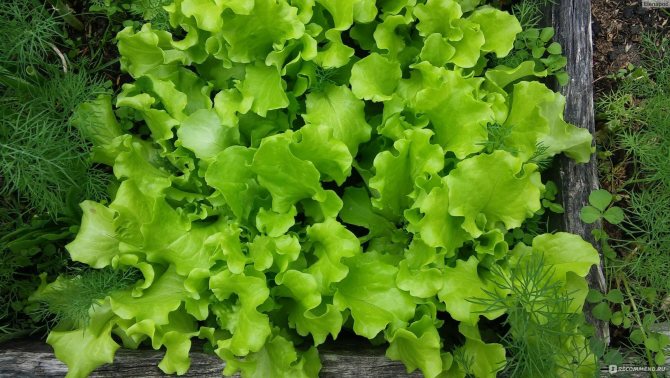

Emerald Lace salad is high-yielding and delicious
The early ripening variety is a relatively young early ripening delicacy. The plant is up to 30 cm high, slightly larger in diameter. The leaves are green, medium-sized, bubbly, of excellent taste. Productivity on par with Emerald Lace.
Seed selection
This plant can only be grown from seeds. You can buy them at specialized kiosks or through the online store. An important condition will be to choose the right variety for planting.
Often, novice gardeners do not lend themselves to cultivating a plant because of the wrong variety. The best option for growing at home would be fast-ripening leafy varieties. For example, you can buy salad "Amanda", "Noran", "Quick", "Yellow". Such varieties of it are not too picky about light, watering, soil. They grow quickly, producing lush greens that can be eaten three weeks after planting in the ground. But head lettuce, on the other hand, is very picky about light, temperature and the distance between plantings. If he doesn’t like something, he may not tie himself into heads of cabbage at all.
Often, watercress is also taken for planting. It is unpretentious and grows in almost any soil, it can be grown with minimal light. Its most optimal varieties are "Curly", "Pepper".
Planting lettuce
Sometimes lettuce is grown by seedlings in order to bring the production time closer, but more often it is sown with seeds directly in the garden.
What soil does a salad need
With any method of growing lettuce, he needs highly fertile soils, not too acidic, moderately moisture-absorbing. The salad is planted in a lighted place, in the absence of drafts, preferably on a small hill. The crop rotation must be taken into account: it is better to plant the salad after cucumbers or cabbage, under which a lot of organic fertilizers are applied. Fresh manure is not used directly under the salad.
With the advance preparation of the bed, compost or humus is added to it, in doses usual for most vegetables. If the soil is not loose enough, sand and peat are added during digging. In the spring, when loosening the beds, wood ash is added to it; it is better not to abuse mineral fertilizers, especially saltpeter.
How to prepare lettuce seeds for planting
Usually there are a lot of seeds in the package, and you can pre-calibrate them by density by placing them in salted water for 15–20 minutes. It is better not to sow floating seeds. Drowned seeds after rinsing with water are disinfected for 15–20 minutes in a pink solution of potassium permanganate. If there are suspicions of the suitability of the seeds, they can be tested for germination in a damp cloth: lettuce seeds are stored for only a few years, after which they are unsuitable for sowing. Good seeds can be additionally soaked in growth stimulants, for example, Epin-Extra (30 drops per 200 ml of water).
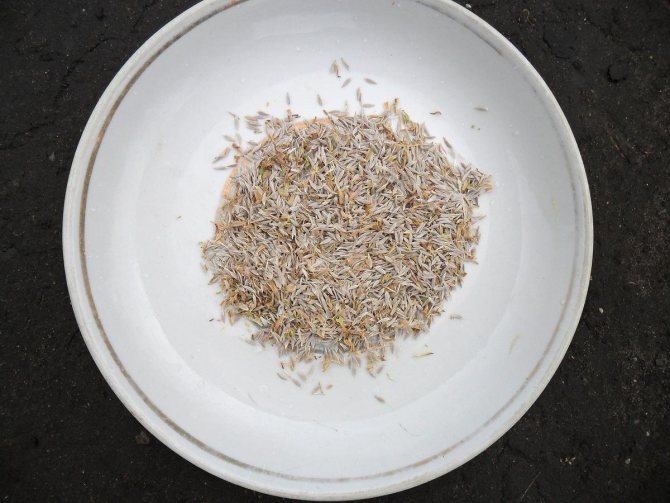

The seeds of the salad are not very small, but it is difficult to sow them by the piece.
When is the best time to sow salad
The salad is very cold-resistant, it reacts normally on a long day, so you can sow it at any time and repeatedly. Usually, lovers of this culture sow seeds on a new bed every two weeks, keeping in mind that harvesting is possible, depending on the variety, 25-50 days after germination.
The first sowing without the use of film shelters is carried out when the night temperatures steadily pass through 0 ° C, that is, in the middle lane in the second half of April. More often they do not wait for this period: they sow seeds as soon as the soil allows, cover the bed with a film, then replace it with spunbond or remove the shelter altogether. Leaves grow most actively at temperatures not lower than 15–17 ° C.
What is the scheme and how you can sow seeds
For lettuce, a separate bed is not always allocated, sowing it as a compacting crop. Where other slow-growing vegetables are planted, you can sow some lettuce, which will have time to grow quickly without interfering with the main crop. If the salad is planted on a separate bed, it is more often sown in rows with a distance between them from 20 to 30 cm, depending on the variety.
It is very difficult to sow lettuce seeds individually, but they try to make sure that there is about 3 cm between them. As the emerging seedlings grow, they are thinned out, using for food; by the time the lettuce is almost fully ripe, about 20 cm is left between the plants. Plants cannot be transplanted.
The sowing depth is 1.5–2 cm, the sowing technique is common: the rows are spilled with water in advance, the salad is sown, the seeds are covered with soil, the track is tamped, carefully watered from a watering can, and a little mulch. Often they do not sow the entire garden at once, but take 1-2 rows every 1-2 weeks.
Video: sowing lettuce
Diseases of lettuce crops
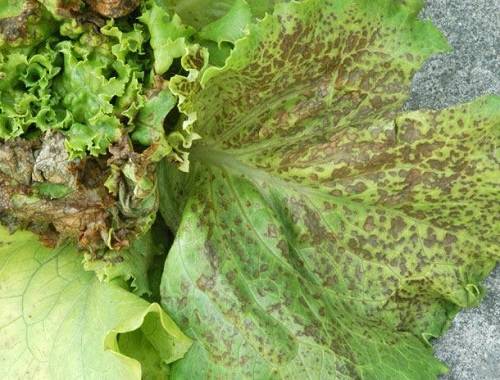

Juicy tender leaves, moisture-loving plants are a temptation for fungal microflora, which also adores moisture and feeds on plant flesh.
Even trees are susceptible to fungal diseases; fragile lettuce is even more difficult in this regard.
His main enemies from the world of fungi:
- Black leg (especially in greenhouse cultivation or in greenhouses);
- Black rot, loving wet years and stagnant waters;
- White rot, like all mushrooms, looking for juicy moist food;
- Downy mildew is an almost omnivorous flora, where there are plants, moisture and heat, there is powdery mildew.
Lettuce, like all greens, is more difficult to protect. After all, it is valuable as a leaf, which means that pesticides are excluded.
They accumulate in the leaves, such products are unsuitable for the table.
Therefore, there are available tools. Our assistants:
- Tomato tops;
- Garlic infusion;
- Potato tops;
- Milk serum.
Of course, they will not help in their original form, you will have to prepare them for spraying.
- Tomato or potato tops are fermented in the heat in an unsealed container - you can use a plastic tank - for several days. They are filtering. It turns out an effective double-acting drug: it will slow down the disease, and scare away pests, some will destroy. It is only necessary to spray the salad crops with the obtained infusion, which is typical for solanaceous solanes. Solanine will not be absorbed by the lettuce leaf, the quality of the product will be preserved. And solanine will have a disinfecting effect on the fungus.
- Garlic, infused in water for a day and strained, is also a medicinal preparation ready for spraying. Due to phytoncides and pungency, the infusion of garlic fights against pathogenic flora and at the same time - against harmful fauna (pests).
- Milk whey is mixed with shaved or grated laundry soap dissolved in warm ordinary water. They take a little soap, for three liters of serum 50 grams. Another drug for fungal diseases. Soap is added for good adhesion to the sheet (then it, having acted on the disease, can be easily washed off by watering), and serum acts with acidity and a set of persistent organic substances.They are useful to humans, but the fungus dies from them.
How to grow a salad
The salad can be planted outdoors, in greenhouses and even in an apartment, using any suitable sized boxes or pots.
Windowsill salad
The container for growing lettuce can be any height, depending on the type of plant, - from 10 to 30 cm. At the bottom, drainage holes are required, through which excess water will drain into the pan after watering. A layer of 2–5 cm of expanded clay or small pebbles is placed at the bottom. Homemade salads grow in almost any soil, but it is better to purchase a universal soil in the store.
The seeds are sown to a depth of about 1 cm, carefully watered, covered with glass and kept in a warm place. Warm seedlings will appear in 4–5 days, at 15 ° C a little later. The box should be immediately placed on a lighted windowsill, the glass removed. Delicate seedlings have to be protected from direct sunlight, but soon they get used to it, there are no problems with growing lettuce at home.
Salad grows in an apartment at any temperature, but if in winter the window is less than 17 ° C, you need to find a place that is warmer, but still well-lit. For most varieties, it is imperative to equip the backlight with fluorescent lamps. They are suspended 50 cm from the plants, they are turned on so that the daylight hours are 12-14 hours. In addition to watering plants, carried out once every 2-3 days, and sometimes more often, in the apartment in winter it is necessary to humidify the air as well.
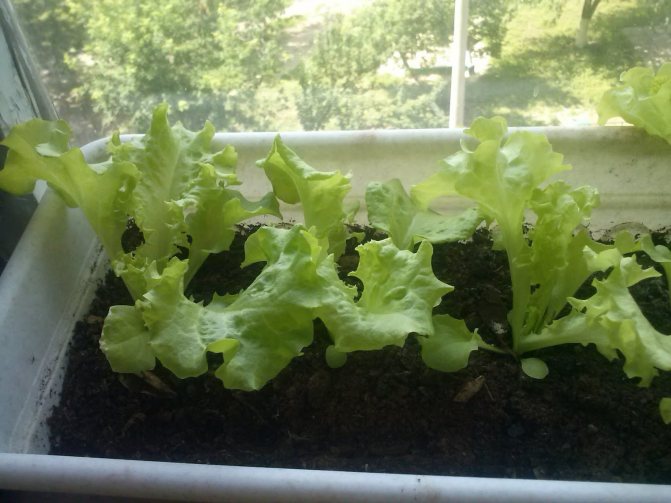

For home cultivation, lettuce is one of the most traditional crops
Plants in pots are thinned out in time: after a week, 4–5 cm are left between them, and then - depending on the characteristics of the variety. Homes usually do not wait until the lettuce is fully ripe, gradually picking off the leaves daily. But with the appearance of flower arrows, the plants are removed and new ones are planted.
Outdoor salad
Growing lettuce outdoors is the most traditional and ubiquitous practice. It can be sown on any free places in the beds at any time, from April to August. Some varieties grow in partial shade, for most, the sun, fertile soil and the absence of weeds are important. The garden bed must be kept constantly moist but clean. Any novice summer resident can grow a salad in the garden.
Growing lettuce in a greenhouse
Only gardeners living in the northern regions, and those who want to receive products very early, take a precious greenhouse place for salad. In a heated greenhouse, you can sow seeds even in winter, in a conventional foil in the middle lane - in mid or late March.
Seeds can sprout already at 5 ° C, seedlings can also tolerate small frosts.
Greenhouse cultivation is the most difficult: in the fall, it is necessary not only to dig up the bed, but also to disinfect the soil, in early spring to create conditions for the soil in the greenhouse bed to warm up more quickly: pour boiling water over it, cover it with foil. And even during the growth of the lettuce (late March - April), cold snaps are possible in an ordinary greenhouse, so you will have to monitor the plantings daily.
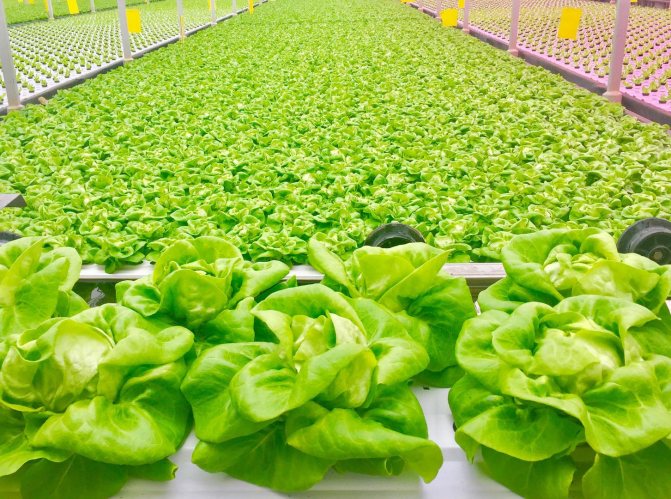

Greenhouse growing of lettuce is more often used in an industrial version.
If, on the contrary, an early heat sets in, the greenhouse should be constantly ventilated. The salad does not feel well at temperatures close to 30 ° C: it tries to discard the flower arrows as soon as possible, and the taste of the leaves deteriorates significantly, they become dry and bitter.
How to care for a salad
The salad requires simple maintenance: all operations are normal for most vegetables.
How to water a salad
Salad is watered frequently: in dry weather almost daily, in normal weather - 1-2 times a week. Leafy varieties can be watered with sprinkling, water at normal temperature. It is better to do this in the morning or in the evening: sprinkling is harmful in the heat. After watering, the soil is slightly loosened, weeds are pulled out, but it is better to keep the garden bed under a layer of mulch.
How to feed salad
They try not to feed the salad during the growing season, counting on the fact that it will have enough of the fertilizers that were introduced during planting. However, if it is noticed that the growth is weak, and the leaves are pale, at 10-12 days of age, you can feed the salad with a weak solution of urea (10-15 g per bucket of water), and later - with an ash infusion. You can also use highly diluted infusions of cut grasses.
How to treat a salad from pests
Salads can get sick with powdery mildew, mosaics, and various rot. But their lifespan in the garden is such that when an illness occurs, there is no question of treatment. Do not treat lettuce and chemicals from pests, the main of which are lettuce flies, aphids and slugs. Flying insects are driven away by various folk remedies: ash and soap infusion, decoctions of tansy, dandelion, nettle, etc. They try to fight slugs with the help of special traps.
Salad cleaning
The salad is removed as needed, pinching off a leaf, and after it has ripened, completely. By the time it ripens, the core of the plant becomes dense and tight to the touch. If you leave the salad in the garden for longer, it will give an arrow and become tasteless. At this time, the plant is cut almost at the surface of the earth. This is done in dry weather so that the leaves do not rot for a longer time during storage. The remains are pulled out and sent to the compost pit.
Video: salads in the garden
Harvesting
Leafy salads reach maturity within 30-35 days after sowing the seeds. After the first collection of leaves, the plant can be left in the garden and after 2 weeks a second harvest of useful greens can be harvested. You can extend the stay of lettuce in the diet by re-sowing seeds in early May. Unfortunately, the summer harvest will be the only one - with an increase in temperature and dry air, the plant will tend to shoot.
The head lettuce is ready to eat after the head is formed. You can get another harvest of such a salad - after cutting a ripe head of cabbage, the plant is left on the root and in a week, young trunks with a rudiment of a head of cabbage will appear on the root collar. One head of cabbage should be left on one plant, and the rest should be carefully removed. This head of cabbage, of course, will be smaller in size than its predecessor, but it will not be inferior in taste and nutritional value.


